I SNAP THE THROTTLE and the Africa Twin bites, I’m not sure who gets the bigger savaging, though – the gravel trail or me? I’ve set the traction control to ‘2’ – which is at the lighter end of intervention, so the rear wheel scrabbles sideways a long way before either me with the throttle or the dazzling duo that are the IMU and ECU (electronic aid masters) pull it back. It probably doesn’t help that I’ve been lumbered with the Adventure Sports with a full pannier and top box set, which add further impetus to the wildly swinging rear end. Not being certain whom exactly is in control, and being pain averse, I reign-in on the skids.
Twenty minutes later I’m making passes along another Sardinian gravel trail for the film-drone. As ever I have to push the pace a little more than I would typically – got to look good for the film – but this time I sense the Adventure Sports is looking after me. It has this semi-active suspension (known as Showa EERA in the tech spec) and while I’m pushing on I can feel the suspension really taking the sting out of the trail, the Adventure Sports ES rides like its ploughing through a duvet (winter weight at that) and the bike undulates more than it pitches. It’s a new feeling, not one I recall from other adventure bikes.
Indeed, inside the 48 hours of the launch there was an awful lot to figure out with the new 2020 Africa Twins, and hopefully evaluate.
THE MODELS
Let’s start at the easy end, and while I fear you know this stuff already, it’s important to be complete – or near complete – on the story.
So for 2020, Honda is producing six variants of the Africa Twin. We’ll start with the CRF1100L Africa Twin (the base model if you like). This comes in two versions, manual (gearbox) and DCT (dual clutch transmission). Plus colour options, obviously (black or red). Then we have the CRF1100L Africa Twin Adventure Sports, which comes with the big 24.8-litre fuel tank, taller screen, cornering lights, tubeless tyres, heated grips etc – and again in manual or DCT options. That makes four bikes; the last ones are then the CRF1100L Adventure Sports ES models – ES is the semi-active suspension upgrade – as ever with the option of manual or DCT transmissions. The Adventure Sports and ES come painted in either the HRC-tricolour we know already (since 2018) or black.
THE ENGINE
The latest engines are very close to those we’ve known since the 2016 reintroduction of the Africa Twin. Those were known as CRF1000Ls, the CRF hinting at the engine’s off-road DNA. Namely the cylinder head features what Honda calls Unicam – as found on their motocrossers and enduro bikes; essentially we’re talking SOHC with a twist, as while the camshaft actuates the intake valves directly it also actuates the exhaust valves via a rocker arm arrangement. It’s both a weight saving and space saving set-up. But the Unicam business aside, connections to the CRF off-roaders do seem somewhat tenuous. Actually, strike that last comment as the Africa Twins’ engine designer (project leader), Nozomi Okada, has been designing and working on the CRF motocross engines since 2010. So yes, there’s a valid connection.
Now while the basic architecture is unchanged for 2020, so much has changed on account the Africa Twin must now meet strict new Euro 5 emissions regulations. Typically, emissions restrictions will strangle an engine, it’ll make less power. Honda has sought to offset this effect by increasing the Africa Twin’s capacity, taking the parallel twin motor up from 998 to 1084cc by way of increasing the stroke from 75 to 81.6mm. That bigger volume needs more combustible gasses so the throttle body has increased from 44 to 46mm and the valves (although diameters unchanged) now have an increased lift, the inlet rising from 9.2 to 10.1mm and the exhaust valve from 8.6 to 9.3mm. The 270º crank with uneven firing interval (270º/450º perhaps? Honda isn’t specific) remains mostly as before (save for a little reshaping), but the upshot is, despite the emissions kit (more on that to come), there’s a 7% power and 6% torque increase.
And despite that capacity increase Honda has been able to make the engine lighter. Using aluminium cylinder liners, a reprofiling of the piston and crank, plus through plenty of other mods, the manual engine unit is now a fair 2.5kg lighter, the DCT 2.2kg less – overall creating a 10% power to weight increase.
Meeting Euro 5 has also made for a more trick exhaust system with dual catalysers repositioned from the muffler to closer to the header pipes, while a LAF (that’s ‘Lean Air Fuel’) sensor (sounds like a super-sensitive Lambda sensor) monitors the exhaust gasses and relays its findings to the ECU for the cleanest air-fuel mixture. The exhaust has a fancy valve in the muffler, too, that lets the gasses out through a small exit pipe at low revs and then switches to a bigger orifice at higher revs.
DCT
Yes, DCT is still with us, and thriving it would seem. Honda say 43% of all Africa Twins sold have been DCTs. It works well at reducing rider effort, is pretty damn smooth in operation and now matched with an IMU (oh, that’s Inertial Measurement Unit) it knows not to change gear when the bike is leant over. So it’s a little more advanced than it was.
As well, remember there’s a choice of three operational modes for the DCT. MT gives you full manual control of the gearbox through the handlebar triggers, D gives you a lazy-boy touring/around-town level of gear-change response whereas S (Sport) makes things move a whole deal faster and there are three sub-levels to that faster, too. At its sportiest the DCT is holding the gears and revving hard for maximum acceleration, while blipping sharp down through the gears under heavy braking.
THE FRAME
Surprisingly, it seems Honda has made the frame lighter and more flexible for 2020. The main spars are now slimmer and the cross brace that went behind the headstock has been removed – this apparently improves off-road performance (more feel one would imagine). Meanwhile the subframe has been separated from the main frame (now bolted-on) and is now fabricated in aluminium. It’s 40mm narrower, which helps when it comes to getting your feet on the floor. The swingarm has also changed significantly. It looks to have been a cast unit previously whereas this new one looks fabricated, albeit in aluminium sheet. All up Honda has shaved 1.8kg from the frame assembly.
THE ELECTRONICS
Here, that IMU is the star of the show, albeit hidden out of sight somewhere around the centre of the bike. It’s a Bosch MM7.10 six-axis unit (if you want to track it down), although actually we’re talking measuring movement in three directions – side-to-side (roll), front-to-back (pitch) and rotation around the perpendicular axis (yaw). For sure, pilots will know all about this. Anyway the measurements of the bike along these axis (axes if we’re being grammatically correct) are used to moderate the traction control, the ABS, wheelies and rear wheel lift.
In Honda-speak traction control is called Honda Selectable Torque Control. It’s not new to the Africa Twin, but for 2020 Honda has spread the seven levels of intervention a little broader and they’ve closely bunched the first four least-intrusive settings (we’d imagine to allow you to fine tune your gravel road power slides) while spacing out the nannying final three more-intrusive levels.
Wheelie control is new, and for some it might be welcomed. There are three settings – big, medium and small wheelies – and if you’re absolutely certain you’ll not flip it, you can alternatively switch it off.
On account of the IMU, the ABS setup is now more sensitive, especially for cornering and the rear wheel ABS can be switched off for off-road (thank you). There’s also rear lift control that adjusts (eases?) the front wheel braking if the rear is coming up too high.
Of course the original rider modes remain: tour, urban, gravel, off road – plus two ‘User’ modes which allow you to custom select the electronic aids (and how much) you want. In the standard four modes (tour to off-road) the power, engine braking, ABS and the activation of the G-switch on the DCT (which makes the bike a little livelier) are all preset, but you can dial in your own choice of traction and wheelie control. The User modes allows you to freestyle on all six of the electronic adjustments.
MULTI INFORMATION DISPLAY
We just call it the TFT screen – but it’s the key to accessing all the electronic aids, and it’s simply light years ahead of the old LED instrument panel, at least in a visual and accessibility sense. Full colour is nice, as is the sharp rendering of the display, and you can choose to have more or less information displayed (in three levels). It’s a touch screen too (when the bike’s stationary) and Connectivity means it can even pair to your phone and it’ll show all your apps and various communications options. When it’s doing this there’s a second smaller LED screen beneath it that keeps you in touch with your speed and gear selection.
SHOWA EERA
Top of the tech heap is the Showa Electronically Equipped Ride Adjustment (EERA) – the semi-active suspension (as found on the ES model). Again this taps into the IMU, but also the ECU and even has its own stroke sensor. Yep, there’s a lot of digital information being swapped between the components on this bike – we can only guess at the computing power this calls for. Working on the information from these three data collectors the EERA control unit responds, making suspension adjustments within an astounding 15 milliseconds. It can even detect when you’re jumping, so the suspension will be ready for that heavy landing. I should add that EERA adopts different preload and damping characteristics depending on what mode you ride in so, for instance, it’ll be altogether firmer if you’re riding in Tour with two people plus luggage.
The ES model brings two more electronic adjustments to the TFT screen’s menu, allowing you to select various levels of electronically adjusted preload (measured in 1 rider, 2 riders, plus luggage increments) and damping effect (preset in the standard rider modes, freestyle in ‘User’).
THE UPSHOT
So the latest Africa Twins are more powerful, lighter (by 5kg) and meet Euro 5. Honda has refined and expanded the electronic rider aids by a fair measure and now you have that option of fancy semi-active suspension that just as importantly is electronically adjustable (so no C-spanners, screwdrivers etc). They’re also slightly sharper on the styling. Oh yes, and the seat on the Adventure Sports / ES has been lowered, back to the 850-870mm of the standard Africa Twin. What’s not to like?
THE RIDING
AFRICA TWIN
The standard 2020 Africa Twin has, it seems, refocused itself as the most off-road worthy option. Alternatively, it might not have changed at all, just the 2020 Adventure Sports/ES has moved further toward the comfortable touring bias? Either way, if you’re looking for the most dynamic package for off-road riding this is the one. Of course, you don’t need me to tell you that – you can tell by the shorter screen, the slimmer rear bodywork, and the smaller 18.8-litre tank. At the launch we could also tell because these were the variants with the proper 50/50 adventure tyres.
And when you do get the Africa Twin off-road it doesn’t disappoint. It edges toward the dynamic ride quite naturally and the suspension settings (spring and damping) feel distinctly firmer than on the Adventure Sports, so you’re inclined to press on without fear of the suspension being overwhelmed.
But first you do have to sort out the electronics. Of course as there are so many adjustments on offer it’s not a quick job to get the settings right. I started with the off-road mode preset, but found the throttle response too slow and the engine braking not enough. Good for green lane bimbling perhaps. So I shortcut straight to the do-it-yourself User screen and, like the meat axe that I am not, dialed in max power response, level two engine braking, off-road ABS with the rear brake ABS off, just 2 on the traction control, together with 1 on wheelie. With these settings the Africa Twin was positively spitting rocks, probably a little too much as it would wreck a rear tyre in no time like this. But certainly it was sporty, real sporty – enough to warrant those KTM bods taking a second, very careful, look at this new AT.
The braking was excellent, it was quite impressive just how hard you could lean on the front brake even in low grip situations and how deftly the rear would swing out as you brake-slid into a corner. The suspension was having a hard time on the mix of loose stone, sand, rock and the odd washout, but it remained in control and it took the occasional sudden hard thumps in its stride without any subsequent under-damped rebound silliness.
The power, dare I say, was more than enough. I have a KTM 1290 Adventure R as a long termer and I would judge the Africa Twin be equally as potent off-road, 158hp or 100hp – at no point do you think ‘I could do with a bit more’.
As well, the DCT version was just as cool when attacking the off-road. Here, I kept the ride mode in ‘S’ (sport) plus 2 bars in the sub-measure, so fairly aggressive. Like this the DCT fair crackled too, and in some ways could have been faster than the manual, as you weren’t spending time and physical/mental effort swapping gears and feathering the clutch. Brake hard, accelerate hard – yeah, it was quick as the manual for sure, and probably easier to ride. Use those finger trigger gear selectors and you can make it more aggressive still. As a big rally bike – I think it could cut it; it’s more than enough.
On road, the Africa Twin is just fine. The short screen doesn’t leave you exposed to a big windblast, far from it. But as it rides very much like the Adventure Sports on road I’ll save further discussion on the matter to the next section.
ADVENTURE SPORTS/ES
Okay, I’ll start with the off-road appreciation of this bike first. Here, the Adventure Sport/ES felt soft. I simply did not feel like attacking the trails on the Adventure Sports anywhere near as hard as I did on the Africa Twin. It just felt too big and the suspension too mellow to cope with a full-on attack. I tried with the electronics to see if I could find a more aggressive setup, but it didn’t seem to want to move (at least as far as the standard model does) toward the dark side.
But here’s the thing – and here I guess I’m talking the ES model – it is nonetheless a great gravel road and off-road ride. That semi-active suspension certainly does something to super-smooth the ride. The best likeness I can come up with is the ride you get in one of those old 1970s Citroen DS saloons (yeah, cast your mind back a long way there – youth, you’re just going to have to take my word on this) with the hydraulic independent suspension. Those amazing old cars kind of floated, and over the trails so does the ES. It’s not like anything else I’ve ridden. It’s not altogether otherworldly, but it’s a marked difference. And so for leisurely off-road touring this is a great, comfortable set-up.
And what it means is you ride along in a lot of comfort, feeling no jarring, no vibrations – although maybe ever so slightly disconnected, which might be disconcerting, at least at first. But that does kind of suit the direction and purpose of this model.
Riding on-road you appreciate different aspects. For a start, being seated you’re much more involved with the dash and various controls. There’s a lot of information and a lot of switches (16 on that left switch block alone) and first rides seem to involve a lot of fiddling about to get to the ride you feel comfortable with. So you’re busy with reading that TFT screen and swapping between modes and settings (all fingers and thumbs). I managed to hop on one of the outriders’ 2018 Adventure Sports and without that 6.5” screen and without all the setup options you instead just get on with the riding – that said, trying to read that old LED screen even for basic info is a chore.
The taller screen on the Adventure Sport/ES is very evident when you’re sat on the bike, too – not something you notice so much when standing for off-road riding. I’m 6’0” tall and it actually felt too tall for me and when placed in the higher position you’re actually looking through the screen, which isn’t something I like doing as a rule. Perhaps the new lower saddle acerbates this. However, the lower saddle does allow shorter people a better chance to get on with the bike (I suspect the 2018 AS was entirely off-limits) and also creates a sat-in as against sat-on feel. For me, I’d select the higher seat positioning for no other reason than I don’t like my knees to be overly bent – at which point I end up with putting too much weight through my spine/ass which gets quickly uncomfortable (like riding a cruiser).
On the DCT bike I didn’t overly enjoy riding in the D mode either (I can be hard to please, it seems). This gives a lazy feel to the throttle action and it seems the engine braking is reduced as well, which makes the bike feel like its coasting in neutral when you’re looking to be decelerating. On road (as with off-road) I felt happier with the responses in the S mode, either with one or two bars showing, this approximated to a conventional throttle-to-power response.
In fact it was when riding sporty that the DCT most impressed. Chasing other journos up a switchback mountain road I was impressed how well the DCT kept up with the manual bikes. It accelerated just as hard, was super crisp on double downshifts when braking hard and, thanks to that IMU, indeed held a gear when leant over in the curves. It did lead to a different style of attack though. Where I might take classically sweeping lines on the manual, carefully timing up and downshifts and feathering the clutch, on the DCT I was inclined to square off the corners and keeping the bike upright longer going in and out of the turns so as to best engage the sporty gear shifts. It made the same speed, but I prefer the riding aesthetic of the manual with all that finessing.
I’m not sure canyon racing is what the Africa Twin and DCT is all about, but it does on some (minor) level show that the system works. For most dirt riders turned adventure riders the DCT isn’t going to appeal, but you can see for the more touring-oriented rider it is of value and does allow that little more relaxation into the ride.
THE WRAP
Honda has done well. The insistence of Euro 5 meant the Africa Twin was going to get a refresh come what may for 2020, but Honda has taken the opportunity to take a fresh look at the design and while they haven’t significantly messed with the formula there is a sense of better definition.
As said over and over, it’s now clear that the standard Africa Twin is the option if you want off-road performance as a priority, equally if comfortable touring is your preference then the Adventure Sports is the call. And for ultimate comfort and ease of use (no tools adjustment) the ES is the top of the heap.
Performance has improved. All the variants are slightly sportier and with the base Africa Twin this does nudge it slightly closer to KTM’s Ready to Race territory, which is no bad thing – it’s a competent and confident off-roader. Meanwhile the ES, with it’s maximum number of whistles and bells wafts ever more into BMW GS ultimate adventure touring homelands.
The electronics have been refined, no doubt, and this works to improve the quality of offering whether off-road or touring is your preference. This has led to more complexity though, between the switchgear and the myriad screen displays and you are left (initially at least) a little confounded. Familiarity with the systems will probably come fairly quickly and most riders will settle on a few favourite settings and simply get on with it. Technophobes will just have to look elsewhere for their adventure succor, but frankly given Euro 5 the days of a simple carburetted adventure motorcycle, with no ABS, no cats etc are long gone – unless you’re prepared to take your chances with ten-year-old secondhand buys.
That said, if you ever rode an old Africa Twin (1990-2003) you would readily relate to these new versions. Generationally these are more powerful, more technical, sophisticated, but the essence of the ride still feels very similar. Then as now, these are comfortable accommodating adventure bikes, more gentle in nature than they appear and as ever occupying something of a middleground in the adventure market. Less aggressive than KTMs, less – I don’t know what – less BMW than BMW?!
Since the comeback in 2016 Honda say they’ve sold 87,000 Africa Twins. That is no small number. Equally, so many of those 87,000 seem to be expressing much satisfaction and are wont to express an unshakeable brand loyalty. Honda is clearly on to a good thing with the Africa Twins. And the latest iterations – yes, they’re better again.
2020 HONDA AFRICA TWIN – ADVENTURE SPORTS – ES
SPECIFICATION
ENGINE | |
Type | SOHC liquid-cooled 4-stroke 8-valve parallel twin with 270° crank and Uni-cam |
Displacement | 1084cc |
Bore & Stroke | 92mm x 81.5mm |
Compression Ratio | 10.1:1 |
Max. Power Output | 75kW at 7500rpm |
Max. Torque | 105Nm at 6250rpm |
Noise Level | 73dB |
Oil Capacity | 4.8/4.3 (5.2/4.7 DCT) |
FUEL SYSTEM | |
Carburation | PGM-FI |
Fuel Tank Capacity | 24.8L |
CO2 Emissions | 112g/km MT 110g/km DCT |
Fuel Consumption | 4.9L/100km (20.4km/L) MT 4.8L/100km (20.8km/L) DCT |
ELECTRICAL SYSTEM | |
Starter | Electric |
Battery Capacity | 12V-6Ah Li-ion battery (20hr) |
ACG Output | 0.49kW/5000rpm |
DRIVETRAIN | |
Clutch Type | Wet, multiplate with coil springs, aluminium cam assist and slipper clutch DCT – 2 wet multiplate clutches with coil springs |
Transmission Type | 6 speed manual (6 speed DCT) |
FRAME | |
Type | Semi double cradle |
CHASSIS | |
Dimensions (L´W´H) | 2330mm x 960mm x 1560mm (1620mm with screen in uppermost position) |
Wheelbase | 1575mm |
Caster Angle | 27.5° |
Trail | 113mm |
Seat Height | 850/870mm (low seat option 825mm, high seat option 895mm) |
Ground Clearance | 250mm |
Kerb Weight | 238kg (DCT 248kg) With Showa EERATM 240kg MT (DCT 250kg) |
SUSPENSION | |
Type Front | Showa 45mm cartridge-type inverted telescopic fork with dial-style preload adjuster and damping adjustment, 230mm stroke EERATM – Showa Telescopic inverted fork with an inner tube diameter of 45mm, and Showa EERATM with compression and rebound dumping adjustments, 230mm stroke |
Type Rear | Monoblock aluminium swing arm with Pro-Link with Showa gas-charged damper, hydraulic dial-style preload adjuster and rebound damping adjustments, 220 mm rear wheel travel. EERATM – Monoblock aluminium swing arm with Pro-Link with Showa gas-charged damper, hydraulic remote control preload adjuster and electric control unit with compression and rebound damping adjustments, 220 mm rear wheel travel |
WHEELS | |
Type Front | 21M/C x MT2.15 wire spoke with aluminium rim |
Type Rear | 18M/C x MT4.00 wire spoke with aluminium rim |
Rim Size Front | 21″ |
Rim Size Rear | 18″ |
Tyres Front | 90/90-21M/C 54H (tubeless type) Bridgestone Battlax Adventurecross Tourer AX41T |
Tyres Rear | 150/70R18M/C 70H (tubeless type) Bridgestone Battlax Adventurecross Tourer AX41T |
BRAKES | |
ABS System Type | 2 channel with IMU |
Type Front | 310mm dual wave floating hydraulic disc with aluminium hub and radial fit 4-piston calipers and sintered metal pads |
Type Rear | 256mm wave hydraulic disc with single piston caliper and sintered metal pads. 2-Channel with rear ABS off mode. |
INSTRUMENTS & ELECTRICS | |
Instruments | LCD Meter, TFT 6.5inch touch panel multi information display |
Security System | Immobiliser, security alarm (optional) |
Headlight | LED |
Taillight | LED |
Electrics | Daytime running lights, Bluetooth audio and Apple® CarPlay, USB socket, auto turn signal cancel, cruise control, emergency stop signal, IMU, HSTC, cornering lights, wheelie control |
.

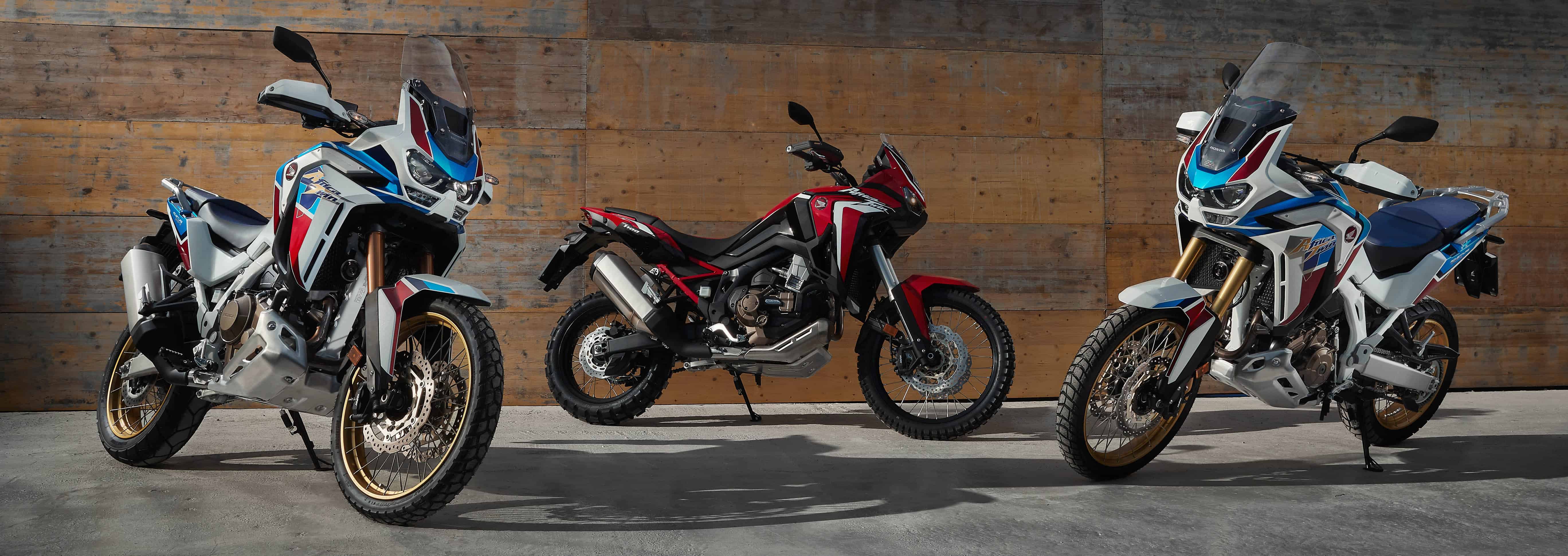

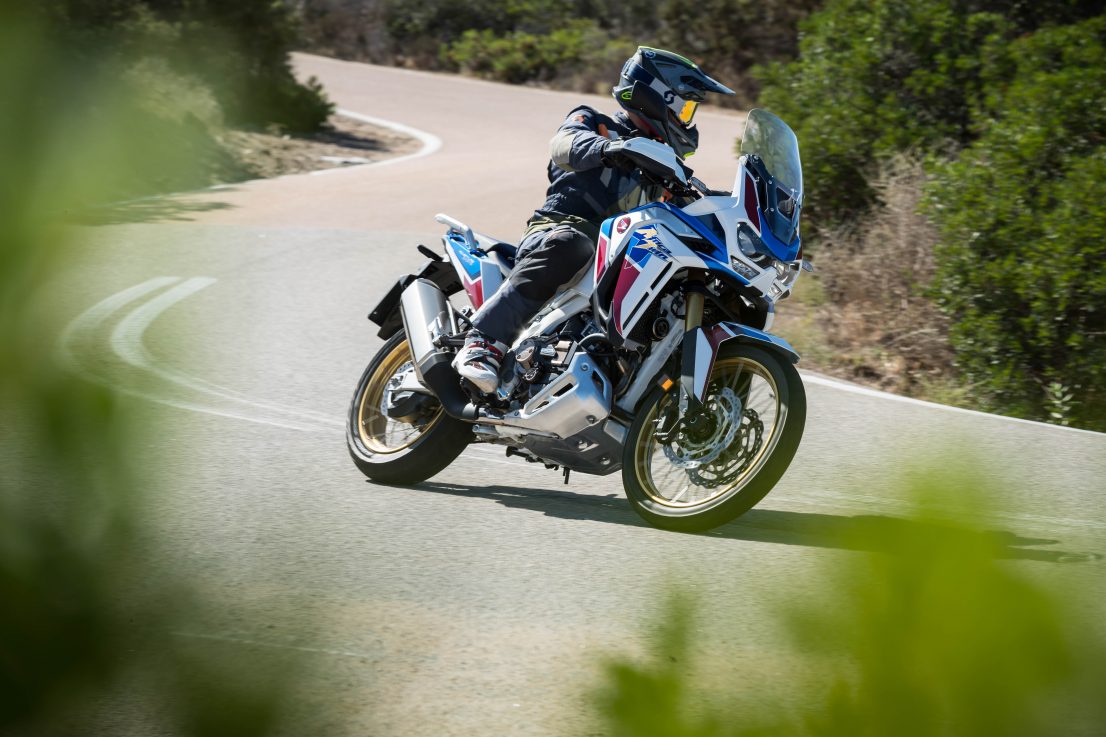
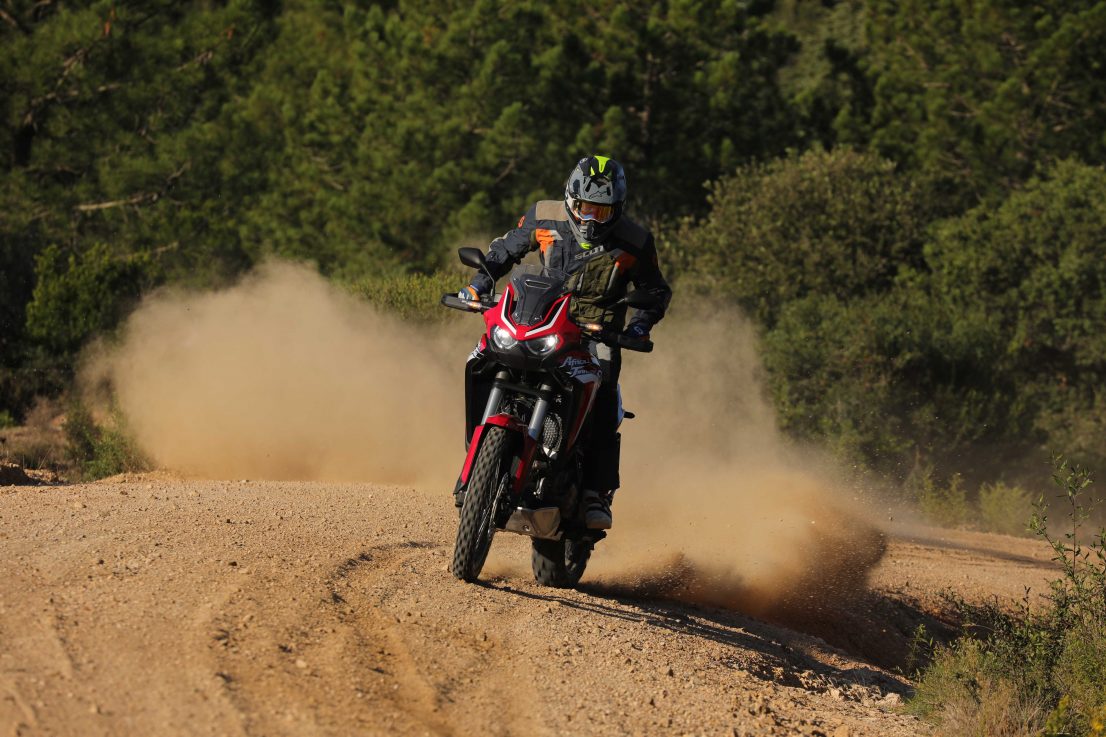
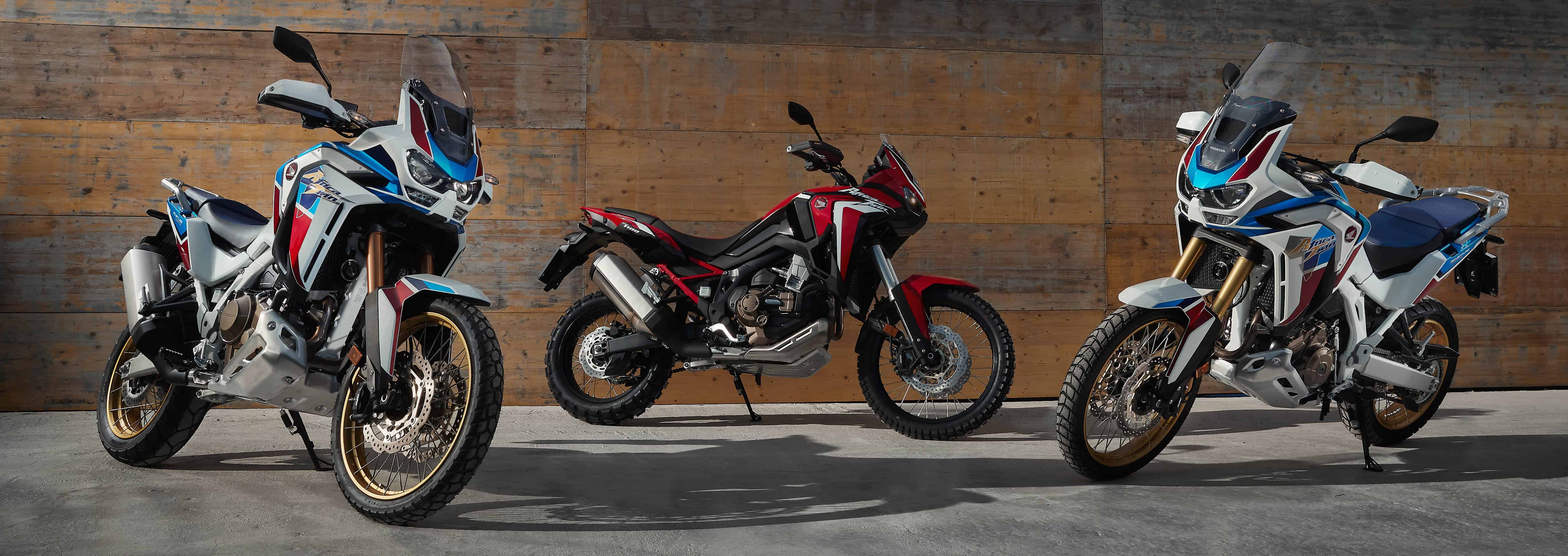
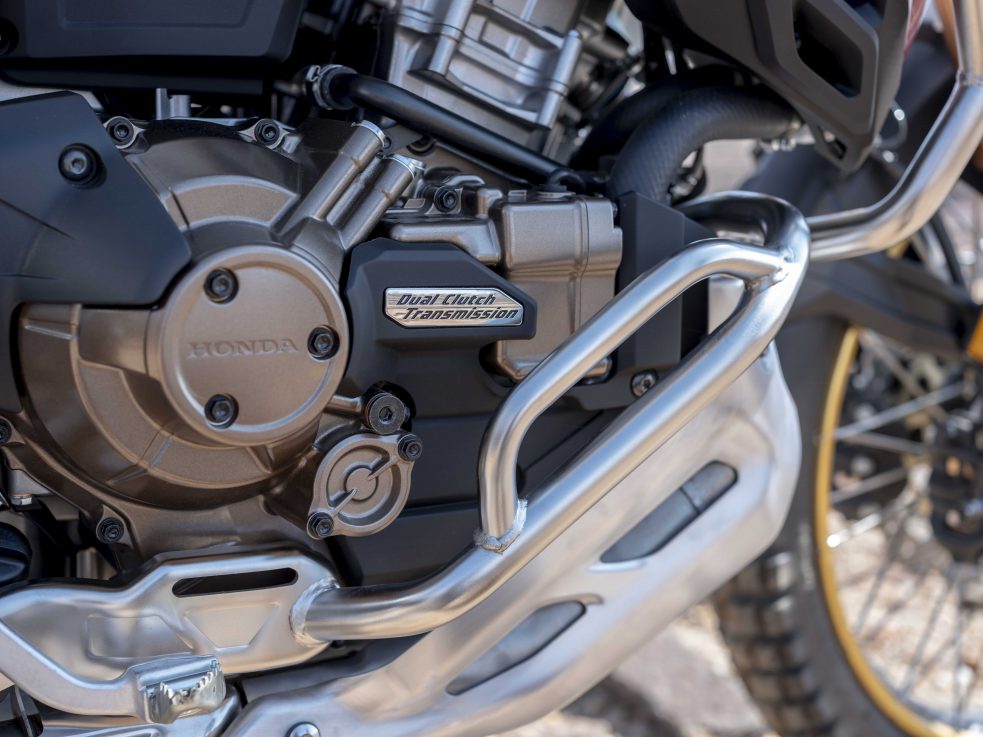
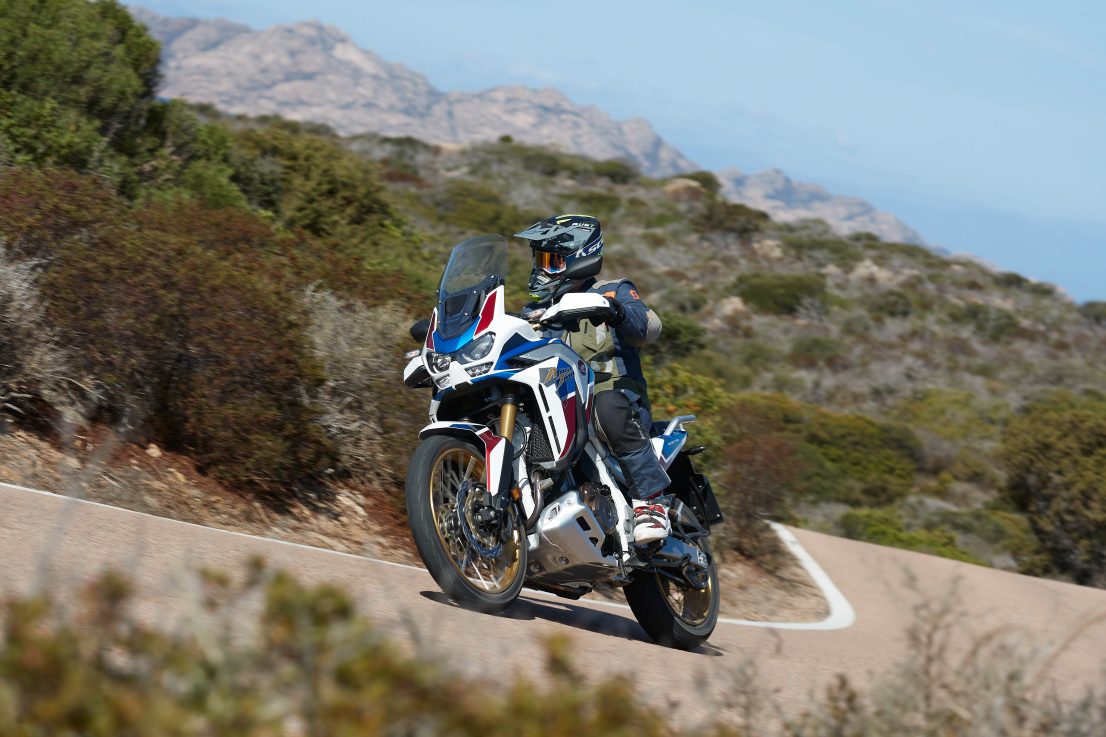
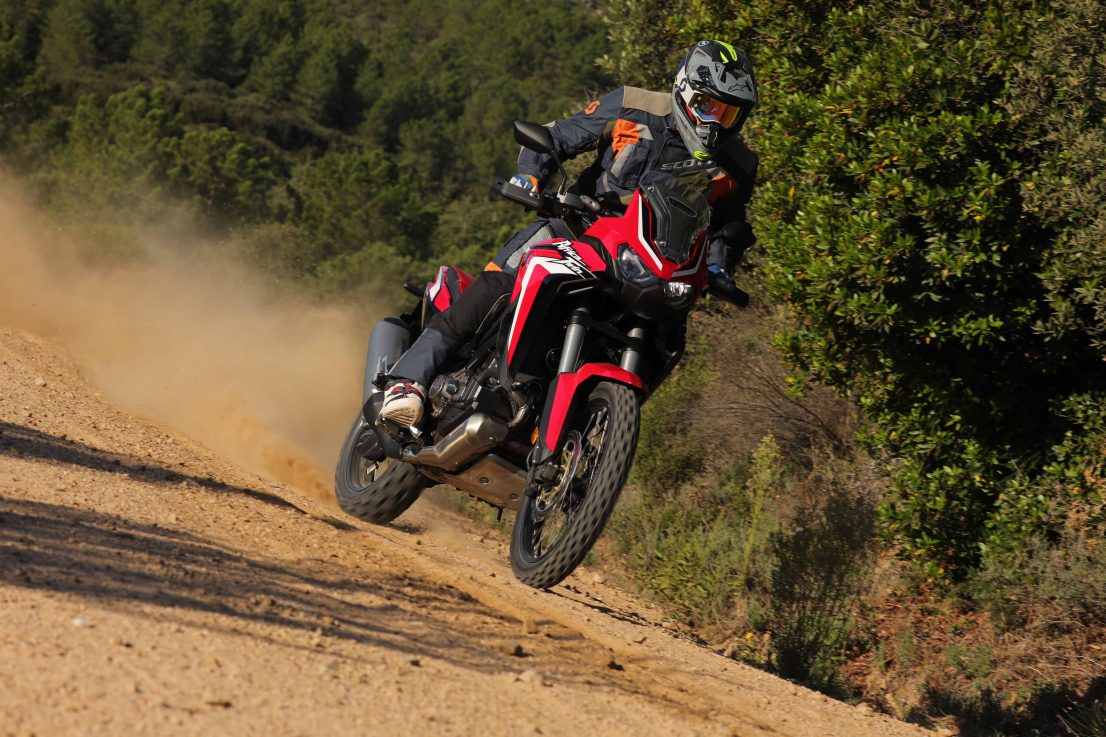
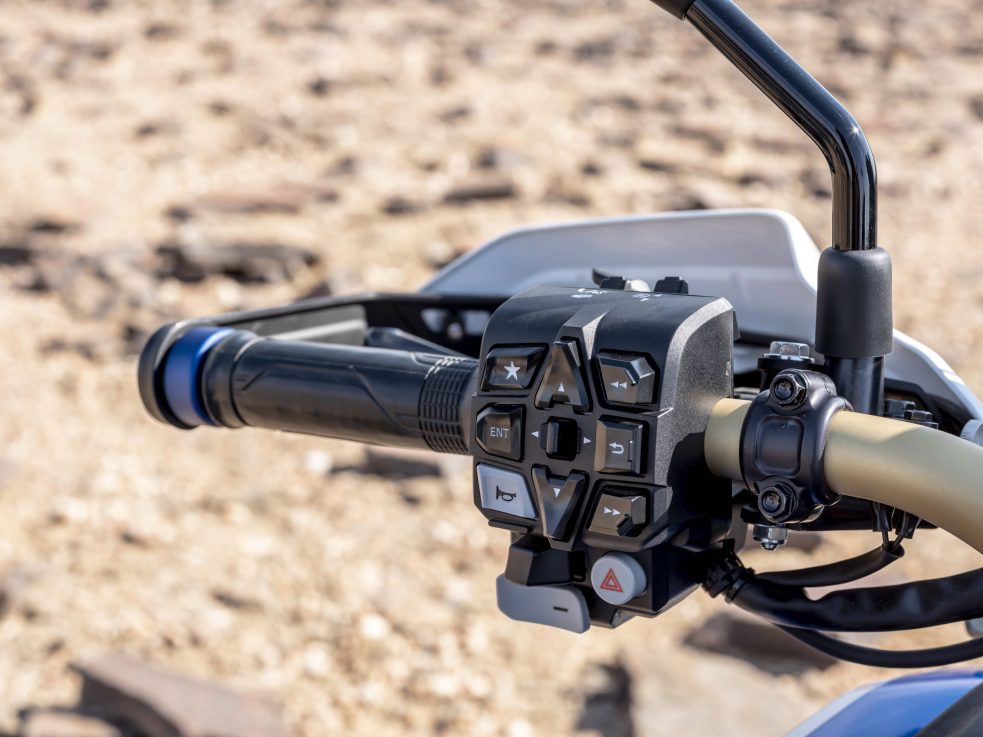
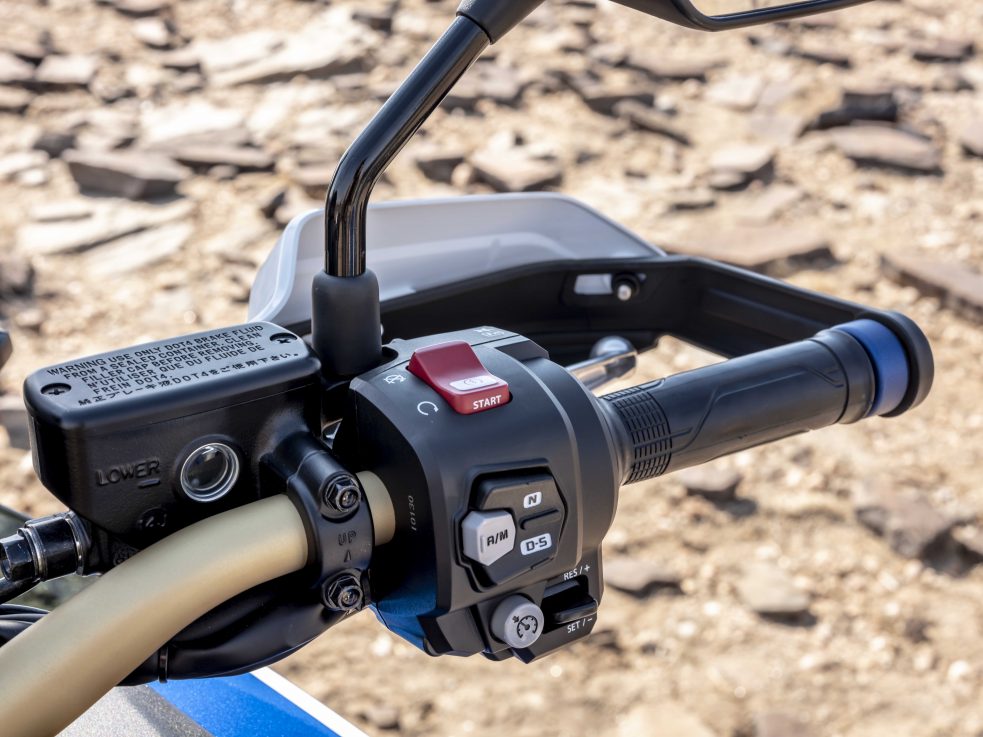
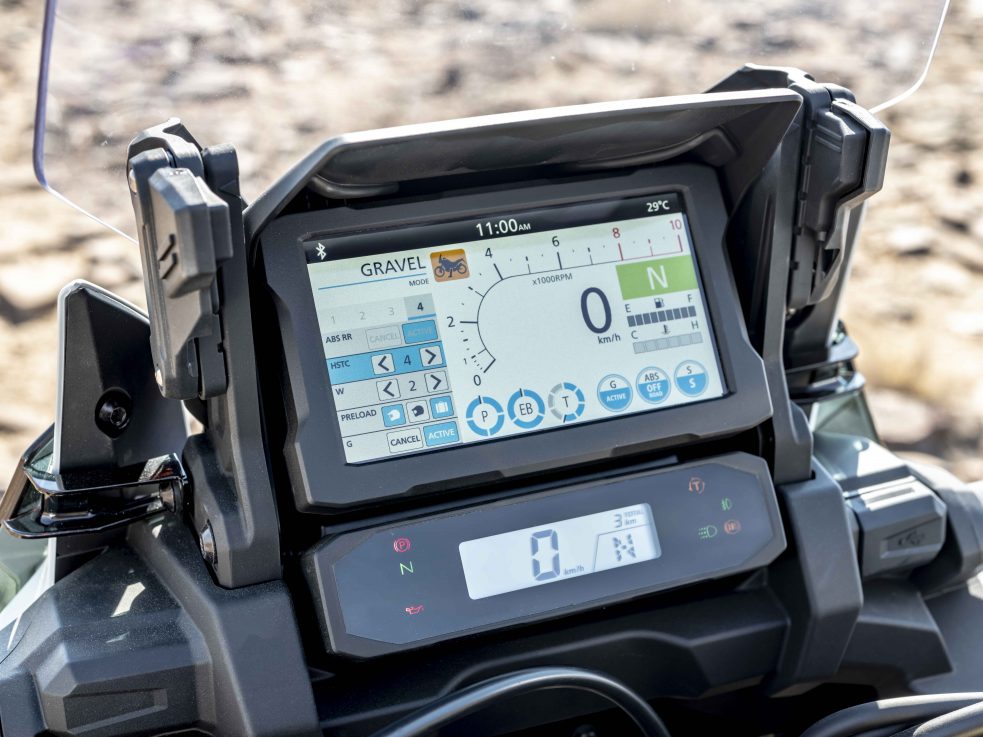
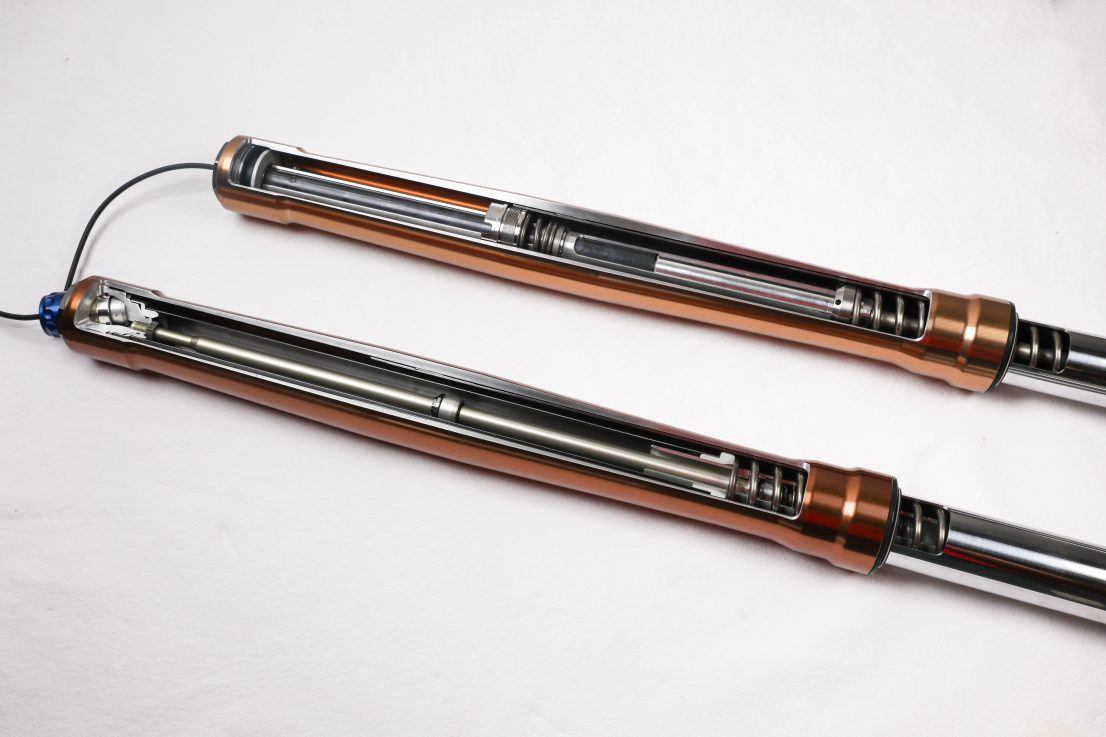
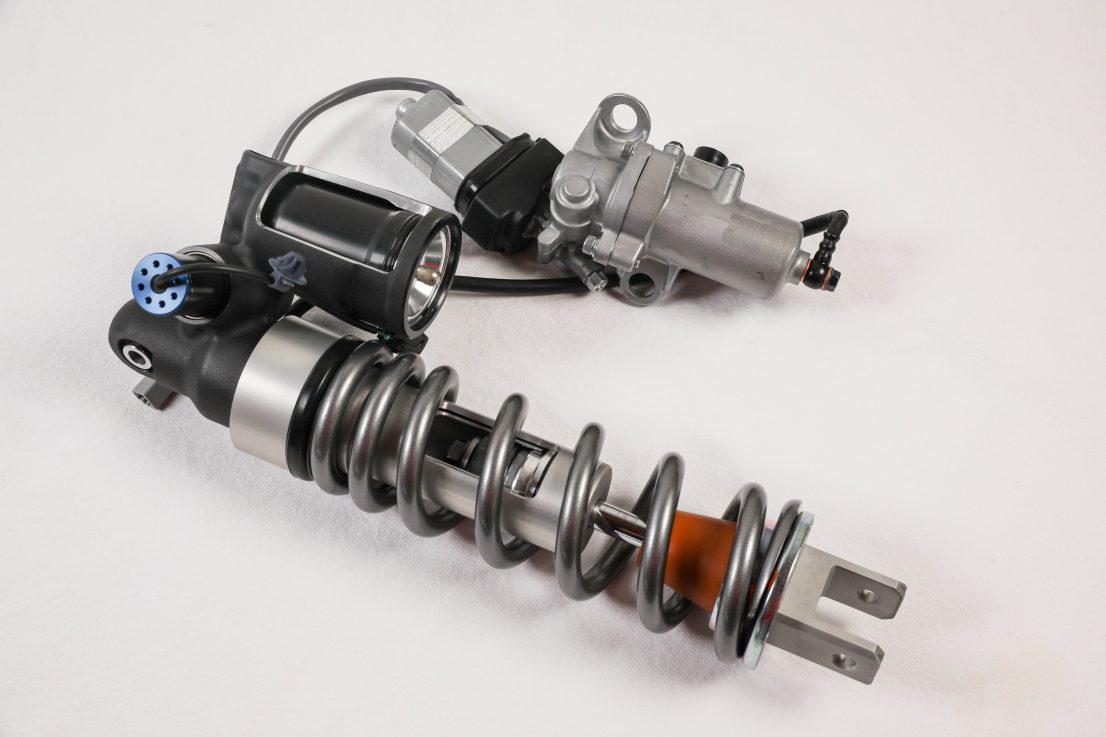
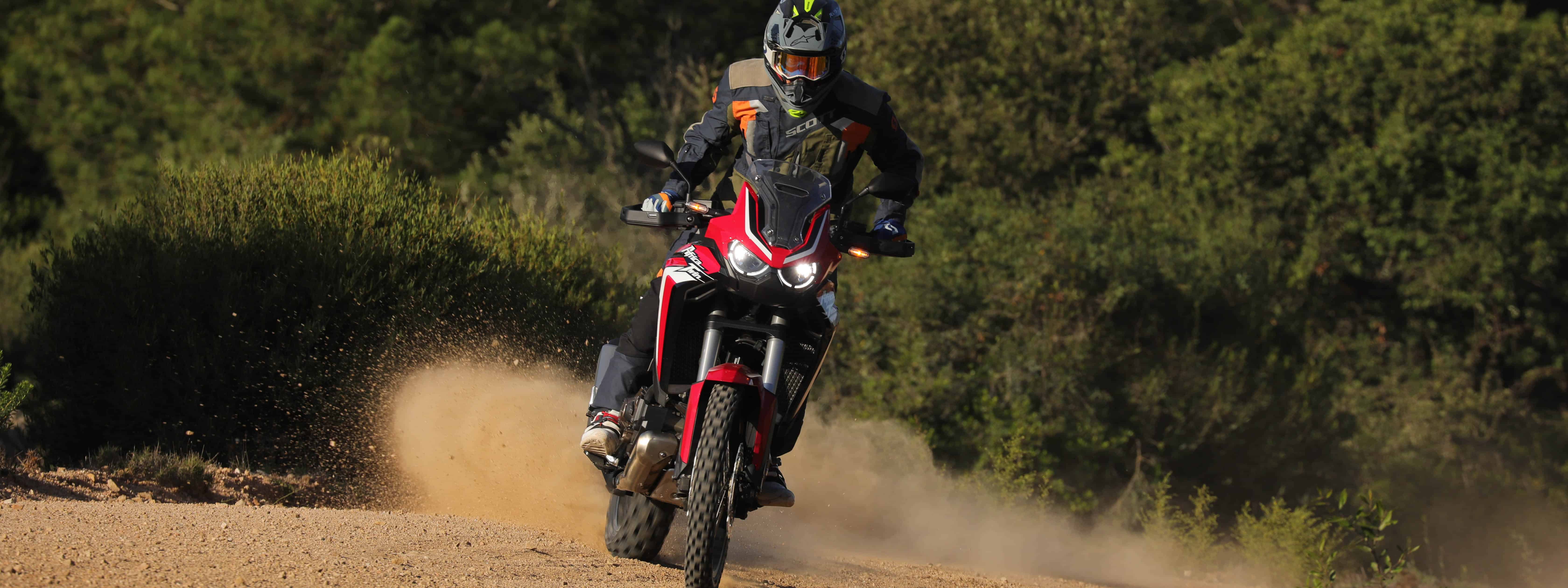
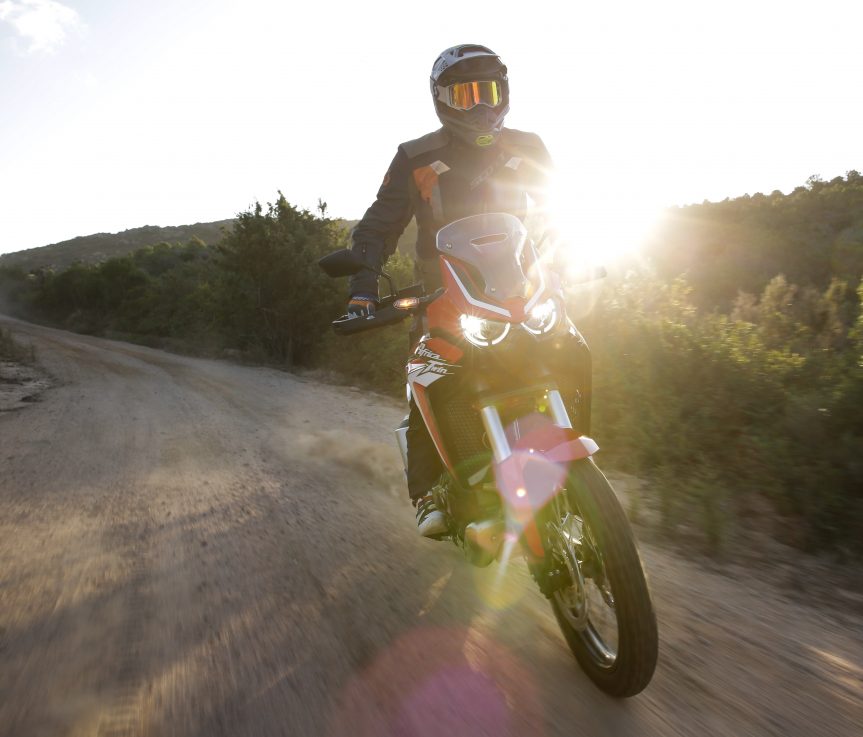
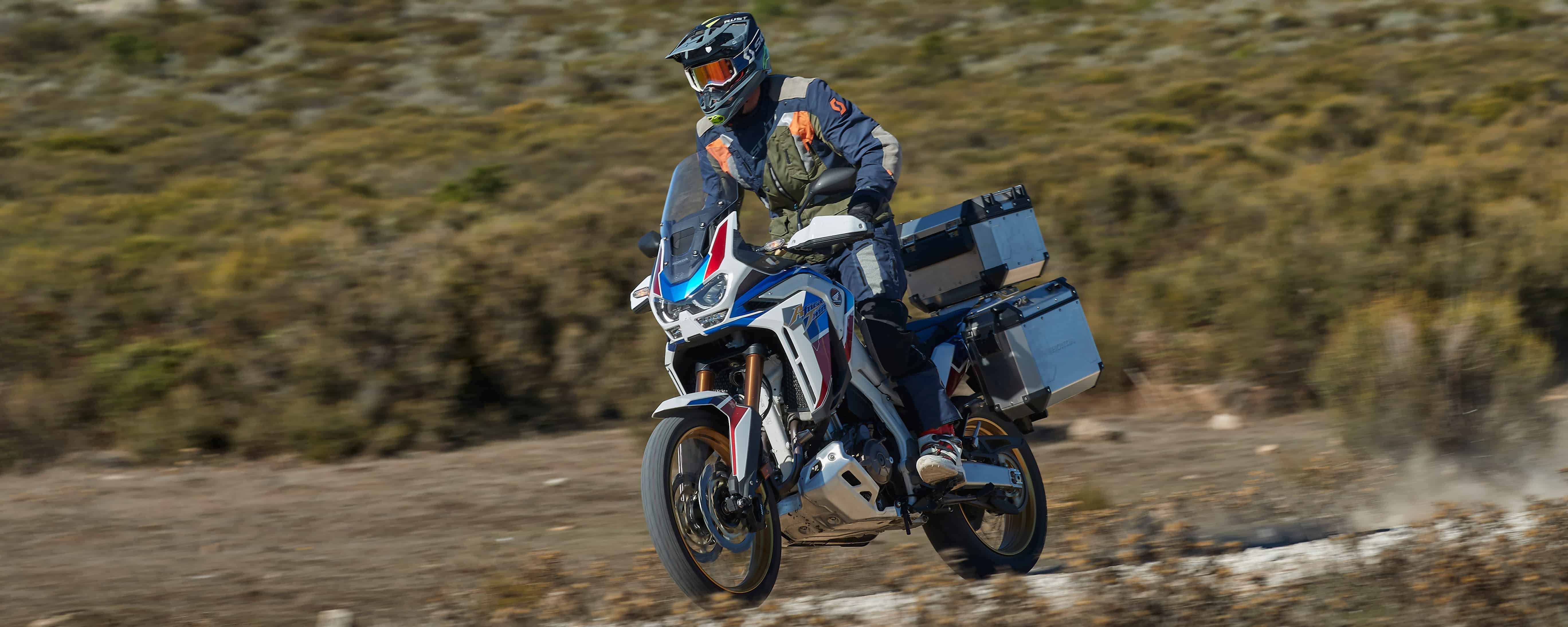
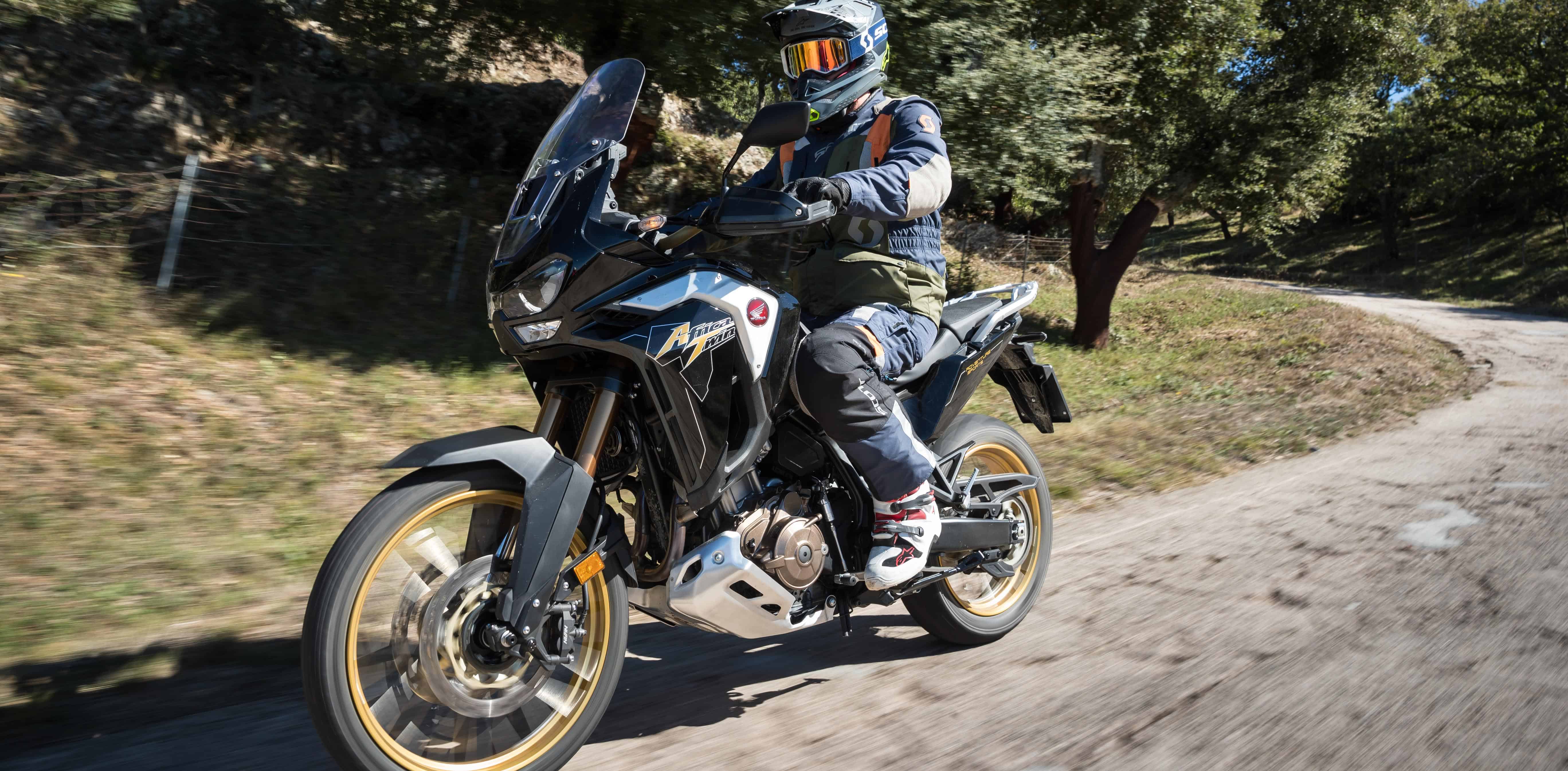
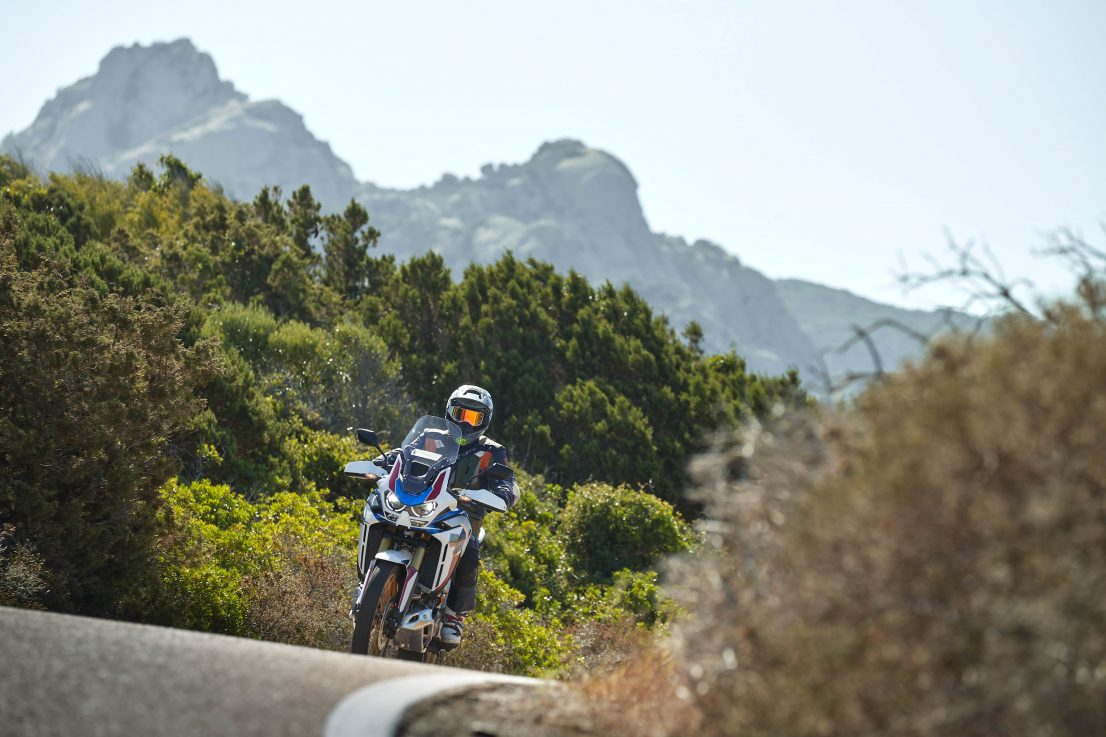
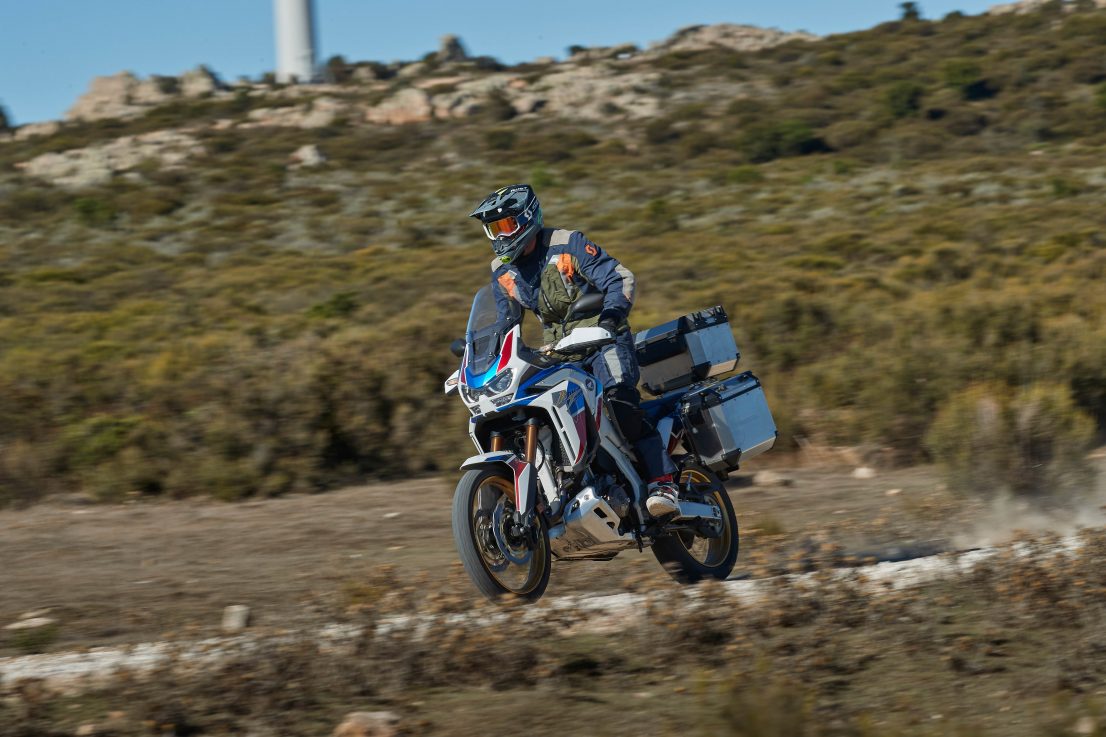
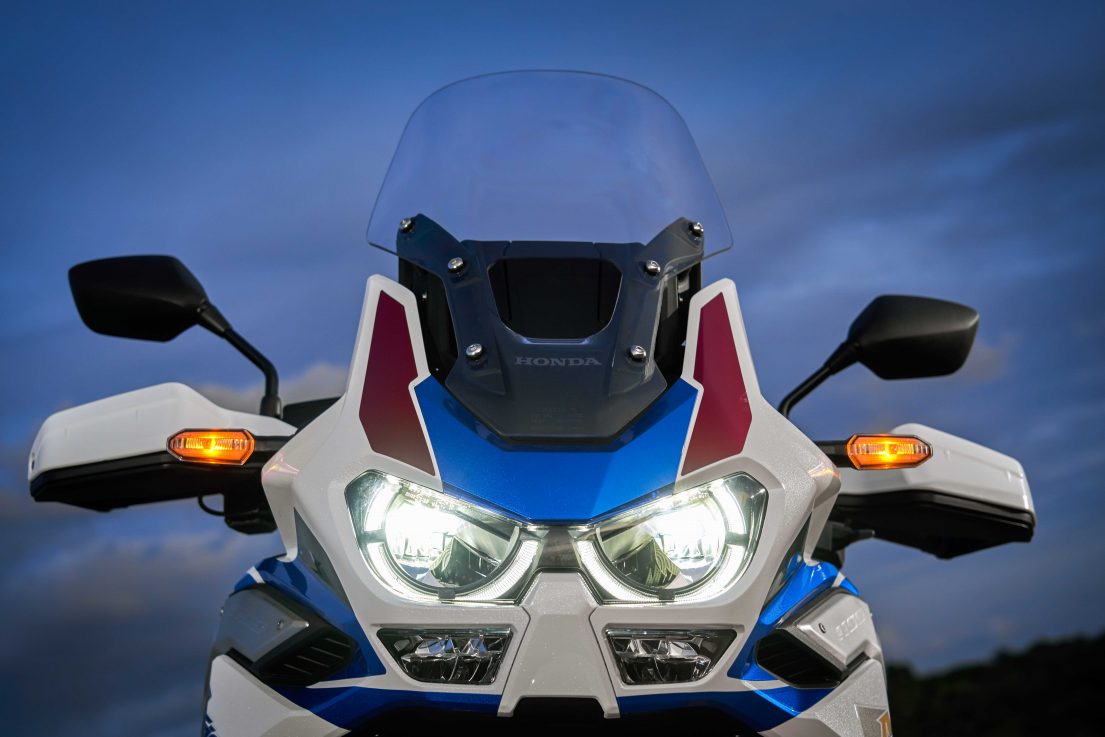
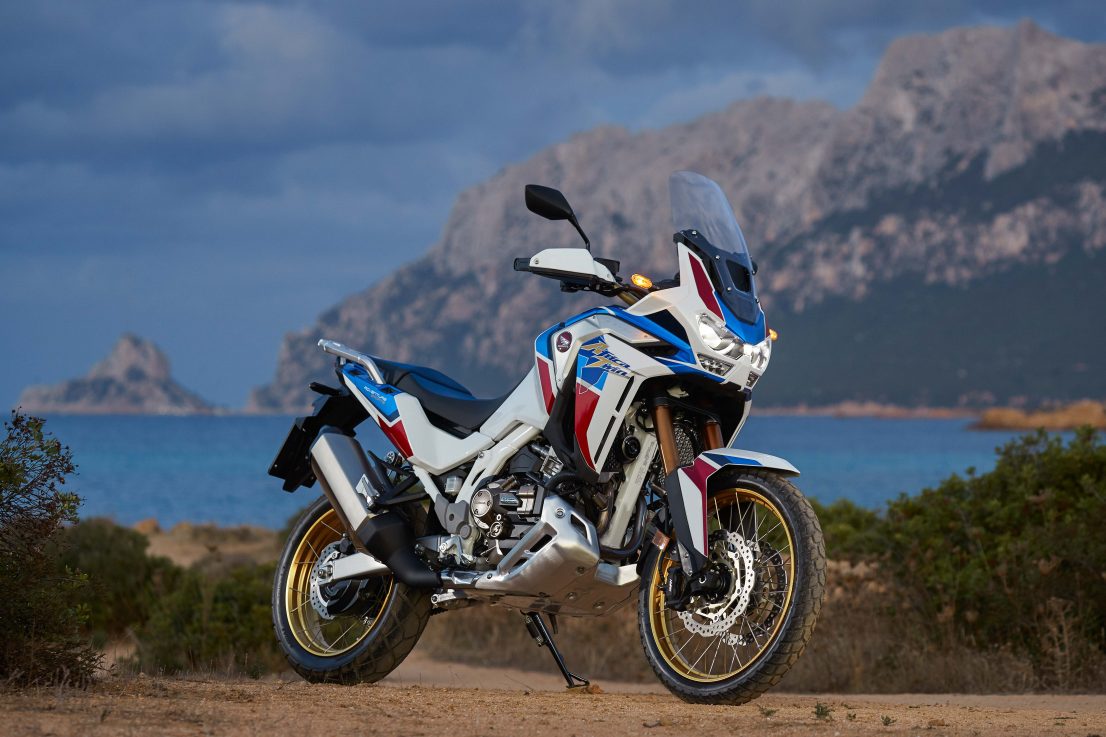
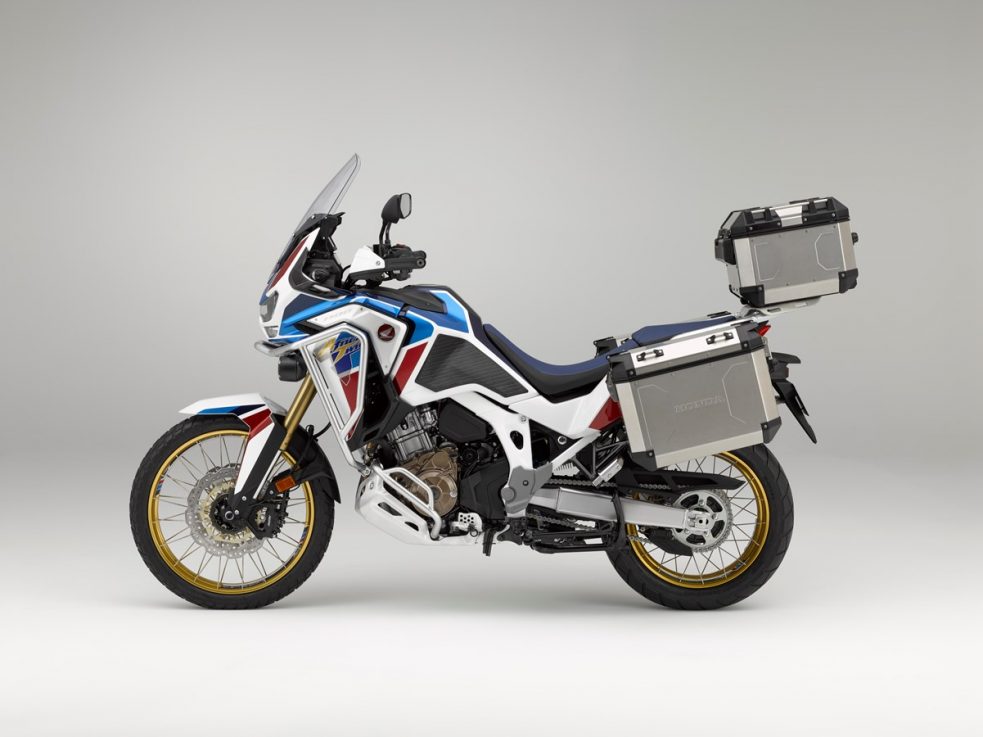
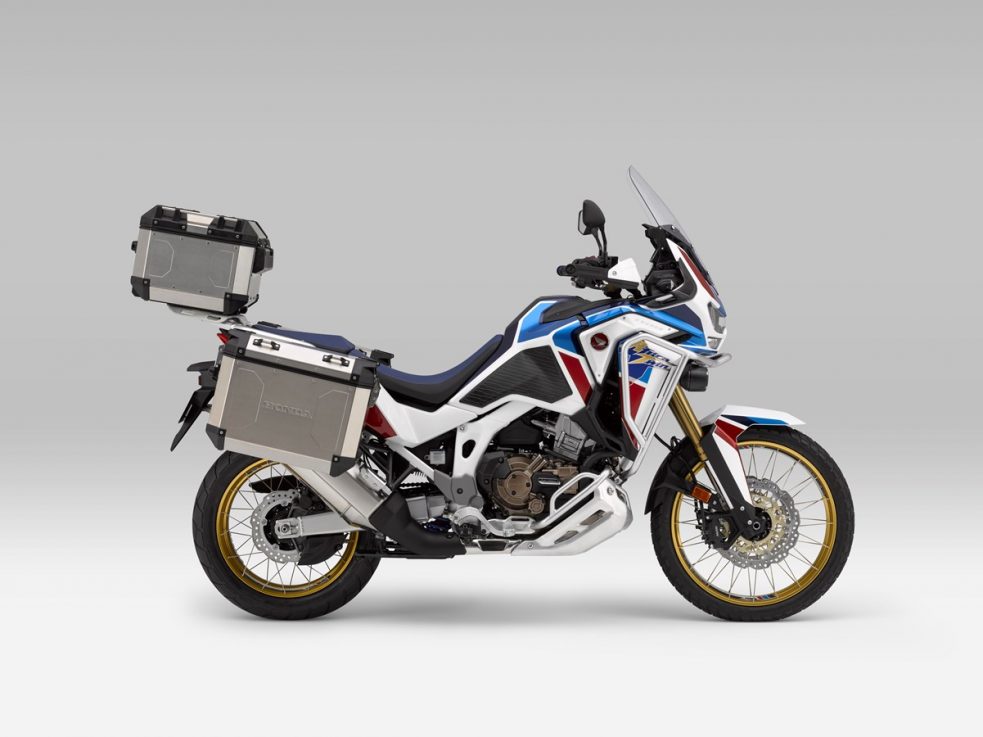
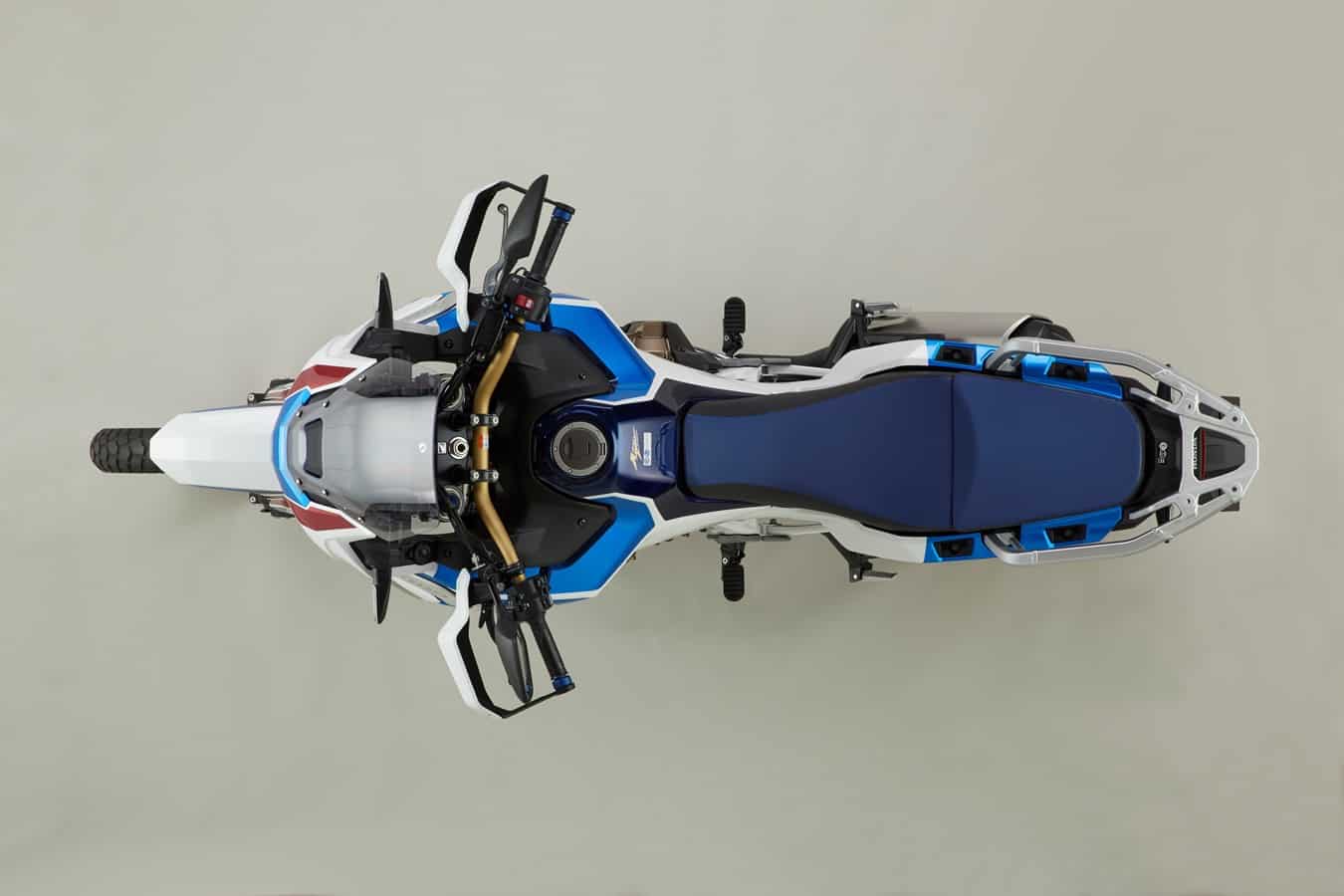
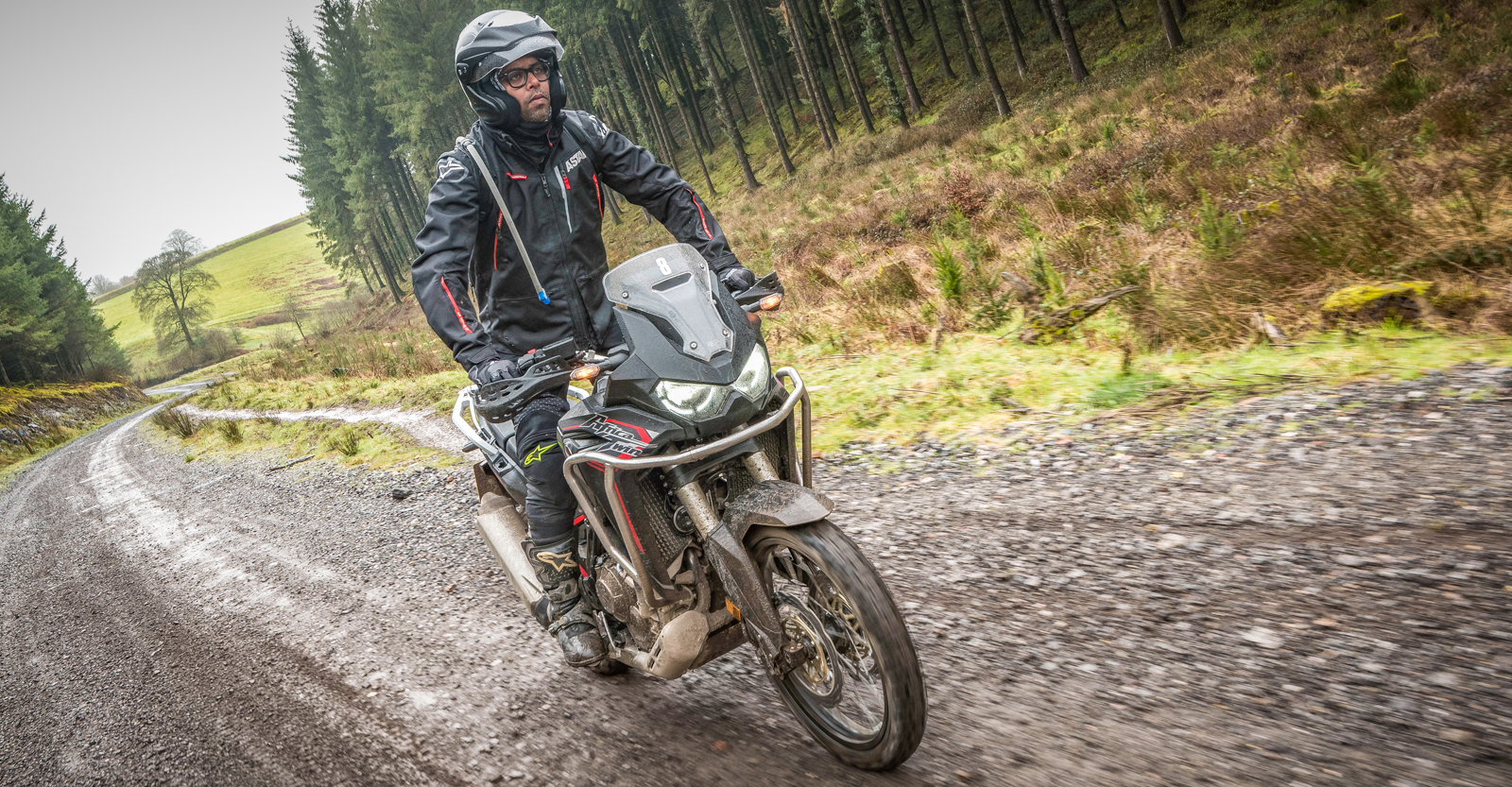
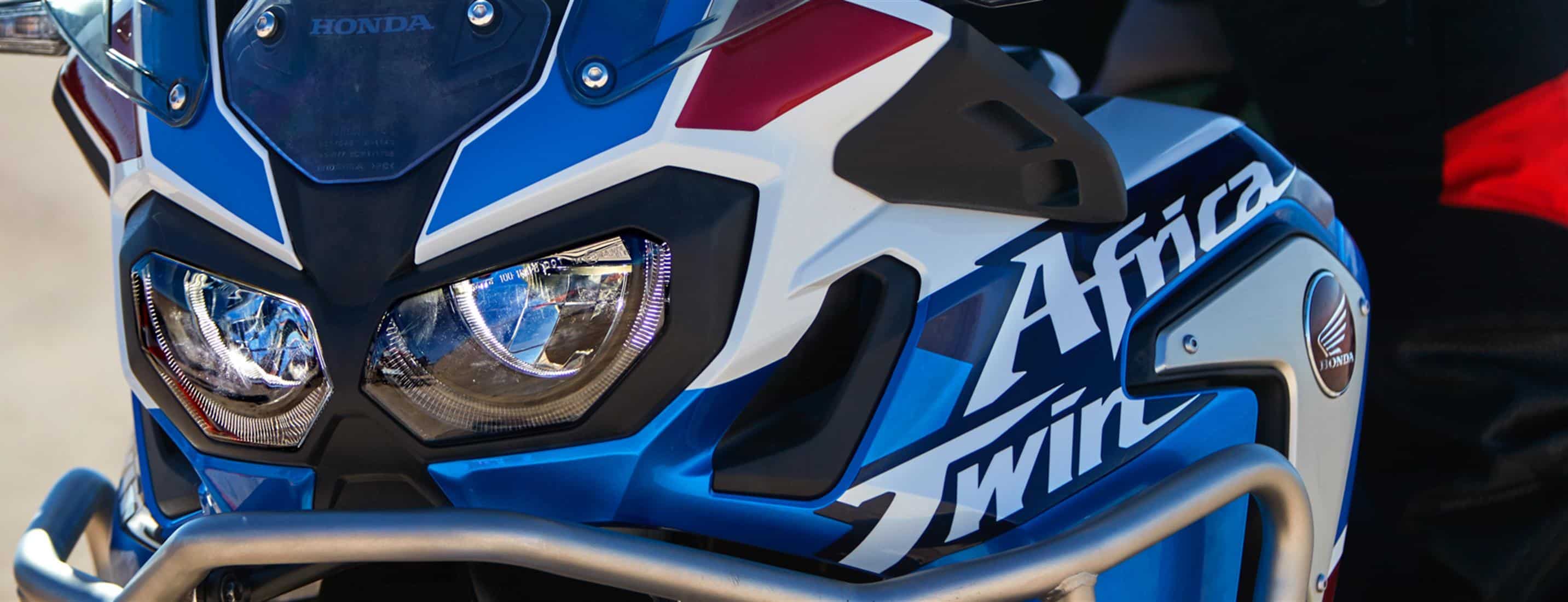
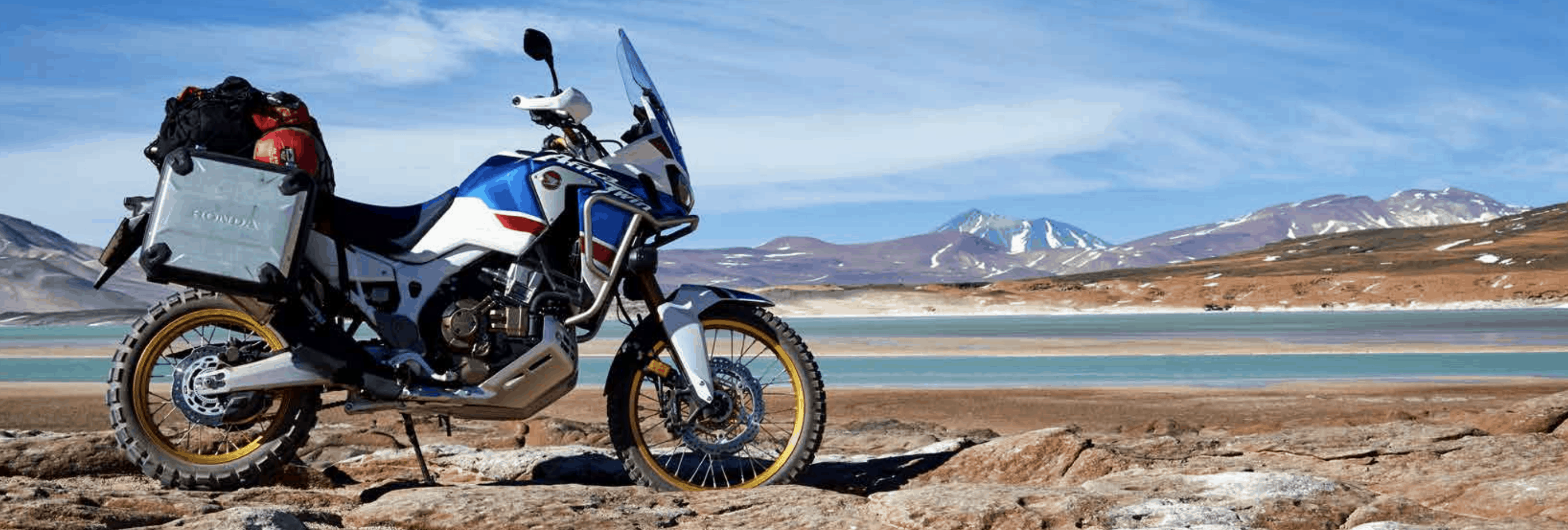

One Response
What is the size of the Honda CRF 1100 Adventure Sport 2020 top box and side panniers